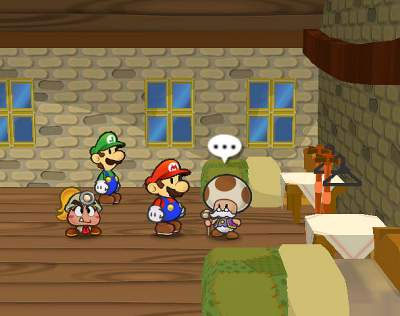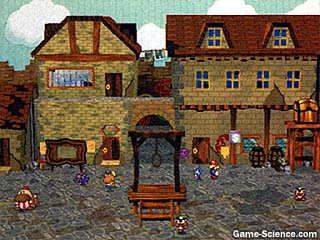|
|

|
BATTLE SYSTEM
|

|
INTERACTION
|

|
ORIGINALITY
|

|
STORY
|

|
MUSIC & SOUND
|

|
VISUALS
|

|
CHALLENGE
|
Easy
|
COMPLETION TIME
|
25-40 hours
|
|
OVERALL
2/5
|
Rating definitions
|
|
|
The first Paper Mario title came in the N64 era, with gamers on that system starved for RPGs. Reasonably well-received, there were nonetheless a number of complaints about various aspects of the overall package. The battle system was overly simplistic, music a definite step down from Super Mario RPG, and there wasn't much challenge to speak of. Now, four years after its initial release, a sequel, Paper Mario 2: the Thousand Year Door, has been added to the mix, and regrettably, things have only gone downhill.
Paper Mario 2 begins with a thematic element common to recent Nintendo titles, a ride on a big ugly boat. Princess Peach, on a cruise vacation stopping in Rogueport, the port for Rogues, (or at least, Bob Ombs with bad pirate accents) has stumbled onto an old treasure map. Since Peach delights in causing Mario trouble, no sooner does she acquire this treasure map than do a bonus group of rogues, the intergalactic space nuisances known as X-Nauts, swoop in to hold her captive. Better yet, Peach is taken to an undisclosed location that couldn't possibly be a moon base or a space ship. With this setup, gamers can perhaps be forgiven for experiencing some trepidation; moon bases (or spaceship prisons) rarely make for good stories, especially poorly concealed moon bases (or spaceship prisons) that are apparently supposed to be a great source of suspense throughout the first three quarters of the game. It's obvious that the princess is being held somewhere off-planet, so why Nintendo would try and play up this element of the story for suspense is unclear, but then, Mario games should never be about the story, as Paper Mario 2 demonstrates in spades, so perhaps the developers can be forgiven.
That leaves the battle system to carry the load, and regrettably, things haven't improved much from the N64 days. While allies are no longer quite as useless as they were in the first Paper Mario, the same old button mashing fights return. As per usual, after an on-screen encounter to determine whether Mario or the enemy begins with a pre-emptive strike, Mario can utilize either Hammer or Glove attacks, while his allies employ a variety of attacks from Koops' shell attack to Ms. Flurry's breath attack, which really blows monsters away. The trouble with these moves is that there really isn't much challenge required to execute any of them, and whereas Mario and Luigi incorporated special attacks very well, this game simply offers Mario a dizzying array of special attacks, and then doesn't provide enough Badge Points to properly test them all out. Certainly, most of the attacks pretty much amount to the same kind of button mashing, but it might have been nice to have the option to actually use some of them, instead of just piling them up uselessly in inventory.
 Mario demands answers, now or eventually
Mario demands answers, now or eventually
|
|
Button mashing isn't the worst failure of Paper Mario 2's battle system, however; even more problematic is the Star Attacks, which players gain by filling up the Star Gauge based upon crowd support. Battles take place on a stage, which increases in size depending upon how popular Mario has become throughout the land, which is to say, what level Mario is. As the crowd gets bigger, each successfully executed move adds more SP to the Star Gauge, which also increases by one star each time Mario completes one of the game's seven worlds. This can also have a downside, however; bigger crowds mean more troublemakers, which Mario has to fight off to avoid having his moves interrupted.
With the stars come special moves, one for each of the game's areas; the trouble with these is, two of them are basically a free heal, while the rest, if executed properly, can end most fights, which effectively eliminates the difficulty from fighting through all but the toughest of the game's dungeons. This setup is eerily similar the system to the Reward Attacks found in Rhapsody, and to think that anyone would think of borrowing an element from that title is a sad thing indeed. Either way, the fights lack the involvement of those found in Mario & Luigi, and in the end, most attacks come down to either mashing a button, or holding it for a while, which is not a terribly exciting way to spend forty hours.
Another area in which one might have expected some improvement over Paper Mario was the overall presentation, but alas - while Paper Mario 2 produced some awfully pretty screenshots leading up to its release, the game itself is anything but. The color scheme is unappetizing, the visuals slightly jagged in a few areas, and overall, the end product is below the usual standards expected from Nintendo. More unfortunate still is the sound, which is bland, bland, bland. While there are two or three tunes with catchy little interludes, the game lacks any memorable music, and worse still, the battle theme is less than half a minute long. This worked in a couple entries in the series because battles did not commonly take more than half a minute, but in Paper Mario 2, any battle with more than two enemies is likely to result in the tune looping, and it gets old fast. Sound effects are good, and the game includes unlockable effects that Mario can find throughout his travels, but overall, the package is far below the standard that Nintendo usually sets with its first party titles.
 Didn't we get enough of this in Wind Waker?
Didn't we get enough of this in Wind Waker?
|
|
Fortunately, not every aspect of the game's presentation is below par; Paper Mario 2 is ably translated, with few errors and a game attempt at local accents, even if those local accents end up sounding a little forced in some instances. The game does not feature anything beyond the most rudimentary voice acting, which will herein be counted as a blessing, and a tidy, if not overly flashy, interface, keeps players moving in the right direction.
The same, however, cannot be said of the game's story, which is unfortunate at best. The treasure map is a very nice idea, as is the thousand-year-old door with something or other lurking behind it, but at no point is there any suspense, and any time things try to get interesting, the gamer is unceremoniously dumped into a sidequest involving either Princess Peach or Bowser. Peach's interludes are just a cut below infuriating, and her captor calls to mind the Simpsons Halloween special in which the titular family is menaced by its automated house. Bowser's misadventures, meanwhile, would be entertaining, since they allow players to go through an ersatz version of old Super Mario Bros. levels, but the levels find themselves dumbed down and without any real purpose or connection to the game itself. And then, too, there is an area that consists of Mario fighting twenty - count 'em - matches in order to get to the top of an arena fighting league with an ever-so-shady boss lurking around the edges. The pacing just doesn't work, and whenever the story threatens to grow interesting, it is immediately doused with either inane sidestories or plain old stupidity, as is the case whenever any of the annoying ghost characters show up. Even more irritating is the GBA SP Mail System, in which Mario receives mail on a GBA. Product placement is bad enough in movies, and it hurts deeply when it occurs in games, especially in the form of townspeople hyping various products. Perhaps this was just an attempt to add depth, however, since there isn't much to be found otherwise. Possibly, this game should be looked at differently than most RPGs, since its story is decidedly light fare, but then again, light doesn't have to mean uninteresting, as previous games in this series have more than ably demonstrated, so even this is no excuse for the banality that rears up again and again.
 Dreary old Rogueport
Dreary old Rogueport
|
|
Perhaps the problem is simply that the Paper Mario series in general is getting old; even venerable series such as Final Fantasy and Dragon Quest have experienced their share of stinkers, so perhaps this game just represents an off-effort by Nintendo's staff. This would certainly play out in view of how little is added to this game that hasn't appeared in other Mario RPG titles; the battle system, the story, even the seven stars - all have shown up somewhere before, and if that wasn't enough, borrowed elements from Rhapsody certainly won't win any points for originality.
Ultimately, Paper Mario 2 probably would have benefited from more development time. Its simplistic battles, unengaging storyline and limp presentation values simply do not match up to the standards gamers have come to expect from Nintendo, and so only the most diehard Mario fans will find much to celebrate here. The game is certainly playable, but it is definitely not memorable, even with its robust 25-40 hour runtime. If memorable is not something you're after, then by all means, pick this one up - but don't expect to be replaying it anytime soon, because while it does feature the option to wander around after beating the game, there really isn't much reason to do so.
Review Archives
|









